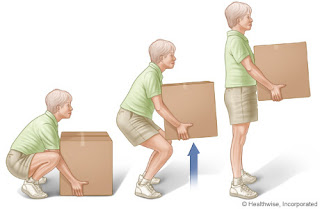 Continuing our discussion from last week (Part 1), we will now look at how you can progress to using the Deadlift in your exercise program and in every day life.
Continuing our discussion from last week (Part 1), we will now look at how you can progress to using the Deadlift in your exercise program and in every day life. Step 3: The Hip Hinge. Once you feel that your butt and hamstrings know how to work, it is time to use your new-found abilities while on your feet. We still are not looking to lift up any weight though, as your body will quickly revert to old movement patterns if overloaded. So start by just practicing the hip hinge. A hip hinge is where you push your butt back while keeping your knees in the same place. You goal is to get your butt back as far as you can while keeping your back straight.
A few tricks that can help: First, practice with your knees touching a bench. As you sit back keep them touching as your butt moves away. Second, as you are coming back up, think of your bridging and try to replicate the motion. You should feel that your butt, not your back, is working to extend your hips helping you to stand up tall. Once you have practiced this move, step away from the bench and practice the movement again. As you will see in the video below, I also use two other cues to help clients achieve proper form. The first is having them hold a stick so that it stays touching their head, upper back, and tailbone. You should be able to perform the movement without the stick coming off of these points. The second cue is to use your hands to press your hips back. Your hips should hinge just below your hip bone, so place your fingers here and press back.
Step 4: The Straight Leg Deadlift (aka the Romanian Deadlift). Now that you have practiced the hip hinge, it is time to pick up some weight. We will still not be picking up anything from the floor though. The goal now is to just learn how to move weight using the hip hinge. To do this, start with a light barbell and set it on a rack at hip height. Take the bar off the rack, move back, and then perform the hip hinge with the bar in your hands. The bar should stay in contact with your thigh on the way down, keeping your arms & back straight. (Note: Pick the bar up from the rack using the same hip hinge you use in the movement. I see too many people that go to lift the bar off the rack before a deadlift, but do not use their deadlifting skills to pick it up!)
Lower the bar as far down as you can while keeping your back straight. If you feel your back bend, you have gone too far. From the bottom position (bar is usually just past the knee) drive through your heels and extend your hips, using your butt just as you did in the hip hinge.
Now that you are starting to use weight, we should also talk about breathing. While it will not be as important with a light weight, learning the proper breathing for lifting weight is always a good idea. For this movement, you will want to take in a breath at the top and brace your abs before lowering. Hold your breath on the way down and halfway on the way up. When you breathe in, you help to stabilize your spine, so it is important that you keep your breath during the most vulnerable position of the lift: the bottom. Once you have momentum on the way up, you can let out some of the air (starting around halfway up), finishing your exhalation at the top.
Step 5: The Deadlift. This step is actually broken into a series of movements that each can be used depending on your abilities. Chances are, even after you have mastered the Straight Leg Deadlift, you may still not have the mobility to properly deadlift (this will depend on how much other work you are doing to loosen up your hips and shoulders). Just because you cannot perform a traditional deadlift does not mean that you cannot progress. Other lifts such as Rack Pulls, Sumo Deadlifts, and Kettlebell Deadlifts can serve as progressions from the Straight Leg Deadlift.
With these more advanced deadlifting variations, you will now need to be especially conscientious about your breathing and positioning. You should take in a big breath before you pick up the weight, and hold it for at least the bottom half of the lift. Some people like holding their breath for the whole lift, some like letting out a little at the top, then holding on the way down, and others like letting out at the top and then taking in another breathe on the way down. I prefer to just hold the whole way, with a slight release on the way up. This is something that you can play with and find what comes naturally to you. As long as you have air in your lungs during the lower half of the movement, you will be helping to stabilize your spine.
For positioning, your main concerns should be keeping your back straight and keeping the bar/weight right beneath your shoulder blades. If we look again at our deadlift picture, you will notice how the figure’s shoulders are actually slightly in front of the bar, but the shoulder blades are right over it. By keeping your shoulder blades over the bar, you will be able maintain a vertical pull.







